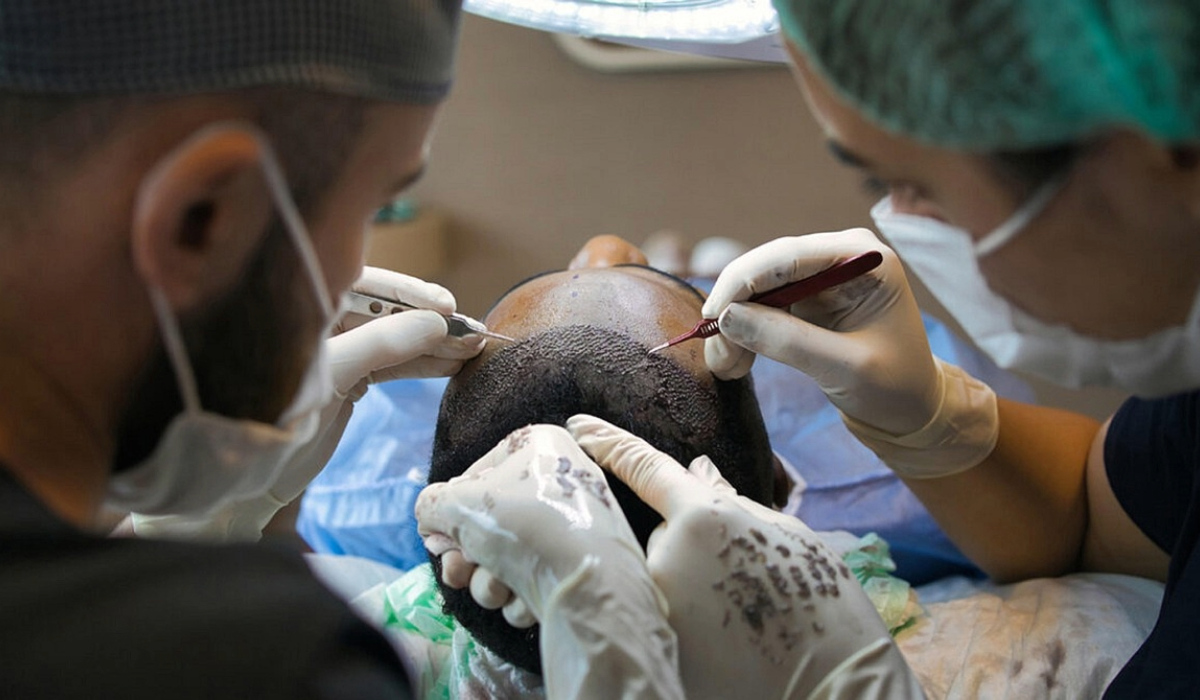What Patients Need to Know for Informed Decisions
Deciding on hair restoration surgery is a significant step for both men and women experiencing hair loss. It’s crucial to understand the types of surgeries available, their benefits, and potential risks. This knowledge will empower you to make informed decisions about which surgical option might be the best fit for your needs and expectations.
Understanding Hair Loss: A Prelude to Restoration
Before considering restoration surgery, it’s important to understand the types of hair loss, such as androgenetic alopecia and scarring alopecia. Knowing the cause, including the role of scar tissue, can help in choosing the most effective treatment.
The Root Causes: From Genetic to Lifestyle Factors
A receding hairline is often the first sign of hair loss, triggered by a mix of genetics and lifestyle choices. Identifying these factors early can guide you toward the best preventative and restorative actions.
Signs to Watch: Thinning, Receding, and Balding Patterns
Noticing a receding hairline can be alarming. This early sign, along with thinning and balding patterns, often indicates it’s time to consider intervention to halt or reverse the process.
Navigating the World of Hair Restoration
Exploring restoration surgery options for conditions like androgenetic alopecia or scarring alopecia requires understanding the impact of scar tissue on outcomes. This knowledge is fundamental in choosing a path that addresses both aesthetic concerns and the health of your scalp.
Hair Transplant Surgery Unveiled
Transplant surgery involves removing hair-bearing scalp from areas of the scalp where hair is plentiful and transplanting it to thinning areas. This procedure includes various techniques like flap surgery, tissue expansion, scalp reduction surgery, and strip surgery. Each method aims to restore a more natural-looking hairline and increase hair density in bald areas. Understanding the specifics of each technique can help you and your surgeon decide the best approach for your needs.
Diving Deep into FUE Hair Restoration
The FUE technique, a popular transplant method, involves taking follicles from the donor area without a strip of skin with hair follicles, avoiding a linear scar. This method focuses on harvesting hair follicles individually for a natural-looking hairline, catering to those seeking minimal downtime and less noticeable scarring.
Beyond Surgery: Complementary Non-Surgical Treatments
The Role of Laser Therapy in Hair Regrowth
Laser therapy has become a promising option for both men and women looking to enhance hair regrowth without surgery. This non-invasive treatment stimulates hair follicles, encouraging growth and thickness.
Microneedling: A Supportive Treatment for Hair Regrowth
Microneedling, often used in conjunction with other treatments, promotes scalp health and hair growth by enhancing the absorption of topical treatments and stimulating the scalp’s natural healing process.
The Impact of Topical and Oral Medications
Topical and oral medications can play a critical role in hair regrowth strategies. These treatments, often used as the first line of defense, can slow hair loss and, in some cases, stimulate new growth.
PRP Therapy: Enhancing Hair Growth from Within
PRP therapy, leveraging the growth factors in your blood, is gaining traction for its role in enhancing hair growth. This treatment, injecting concentrated platelets into the scalp, supports hair follicle health from within.
Preparing for Your Hair Restoration Journey
Embarking on restoration surgery is a journey requiring careful planning and realistic expectations. Understanding the process, recovery times, and potential results is key to a satisfying experience.
Selecting the Right Procedure: Matching Treatment with Hair Loss Type
Choosing the right procedure, whether it’s a beard transplant for men, addressing bald areas, or treating pattern baldness, requires a comprehensive evaluation of your hair loss type, scalp health, and aesthetic goals. Considerations like low-level laser therapy for scalp rejuvenation or scalp micropigmentation for fuller-looking hair can also complement surgical options. Remember, research is needed to determine the most effective combination for your unique situation.
Setting Expectations: Recovery Times and Procedure Outlines
Understanding recovery times and what to expect during and after the procedure will help you prepare mentally and physically for the journey ahead. Each surgery and treatment has its own timeline and set of post-care instructions, crucial for achieving the best outcomes.
Financial Considerations in Hair Restoration
When considering hair restoration surgery, understanding the financial investment is crucial. Costs can vary widely based on the type and extent of the procedure needed. From the initial consultation to the surgery itself and any follow-up treatments, each step has associated costs. It’s important to factor in these expenses while planning your hair restoration journey.
Navigating Insurance and Hair Restoration Surgery Costs
Most insurance plans do not cover hair restoration surgery since it is often seen as a cosmetic procedure. The cost of surgery can depend on several factors, including the number of follicular units required and the technique used, such as FUT or FUE hair transplant. In FUE hair transplant, a micro punch is used to extract individual follicular units, and the surgeon harvests these units one at a time, which can be more labor-intensive and potentially cost more. Additionally, any medications or supplements recommended post-surgery to enhance results will add to the overall expenses.
Enhancing Results: Combining Procedures for Optimal Outcomes
Combining surgical procedures with non-surgical treatments can significantly enhance hair restoration results. Procedures like FUE hair transplants can be complemented with PRP therapy or laser treatments to stimulate hair growth and improve the health of the scalp. This integrated approach can lead to more natural-looking outcomes and higher satisfaction rates among patients.
It’s essential to have a comprehensive treatment plan that includes both surgical and non-surgical options. By assessing the specific needs and goals of each patient, a personalized plan can be developed. This may include a combination of FUE or FUT procedures, along with supportive therapies such as microneedling or medications.
Ultimately, the goal is to achieve the most natural and long-lasting results. Combining different procedures allows for a more holistic approach to hair restoration, addressing various aspects of hair loss and scalp health. A thorough consultation with a qualified surgeon can help determine the best combination of treatments for each individual case.
The Post-Procedure Roadmap
After undergoing hair restoration surgery, understanding the post-procedure care is vital for ensuring the best outcomes. A detailed aftercare plan, including instructions for washing and treating your scalp, will be provided by your surgeon.
Aftercare Essentials: Ensuring the Best Outcomes
Following restoration surgery, adhering to aftercare guidelines is crucial for optimal healing and hair growth. This includes gentle handling of the scalp, avoiding direct sunlight, and using recommended shampoos and conditioners. Your surgeon will guide you through the aftercare process, highlighting the importance of each step.
Lifestyle Adjustments: Maximizing the Longevity of Results
Making lifestyle adjustments post-surgery can greatly impact the longevity of hair restoration results. This includes maintaining a healthy diet, minimizing stress, and avoiding harsh chemicals or styling practices that could damage your new hair.
Frequently Asked Questions
Patients often have many questions regarding hair restoration surgery, from addressing concerns about pain and the visibility of results to understanding the maintenance required post-procedure. It’s important to have these questions answered to feel confident in your decision.
Addressing Common Concerns: Pain, Results, and Maintenance
Many worry about the pain associated with surgical procedures. However, advancements in techniques have made these procedures more comfortable, with minimal discomfort reported by most patients. Results can vary, but the aim is always for a natural-looking hairline. Maintenance involves following your surgeon’s aftercare instructions closely.
Debunking Myths: Age Limits, Stress Factors, and Visibility Post-Surgery
There are many myths surrounding transplant surgery, such as strict age limits or the impact of stress on results. In truth, men and women of various ages can benefit from restoration surgery, and while stress can affect hair loss, surgical hair restoration can still be effective. The FUE technique, in particular, offers discrete results with minimal visibility of the procedure.
Taking the Next Steps: Finding the Right Surgeon and Support Network
Choosing a qualified surgeon experienced in plastic surgery and hair restoration is crucial. Researching their background, reviewing before-and-after photos, and reading patient testimonials can provide insight into their expertise.
Additionally, consulting with multiple surgeons can give you a broader perspective on your options and help you feel more confident in your decision. It’s also helpful to connect with previous patients or support groups to hear about their experiences firsthand.
Ultimately, building a support network of friends, family, and professionals who understand your journey can provide emotional encouragement and practical advice as you navigate your hair restoration path.
A Glimpse into the Future of Hair Restoration
The future of hair restoration looks promising, with ongoing research and technological advancements aiming to enhance results and patient experiences.
Emerging Technologies and Techniques on the Horizon
Innovations in hair restoration continue to evolve, promising even more effective and natural-looking solutions for hair loss. From advancements in robotic surgery to new growth factor treatments, the future holds exciting potential for patients seeking hair restoration.
Making the Decision: Is Hair Restoration Right for You?
Deciding on hair restoration is a personal journey that requires careful consideration of your goals, expectations, and the realities of what treatment options can offer. It’s important to weigh the potential benefits against the financial and emotional investment involved.
Consulting with a qualified professional can provide valuable insights into the most suitable options for your specific type of hair loss. They can help you understand the pros and cons of different approaches, from surgical procedures to non-surgical treatments.
Ultimately, the decision should be based on a comprehensive understanding of what hair restoration can realistically achieve for you. By setting realistic expectations and choosing the right treatment plan, you can embark on a journey toward regaining not just your hair but also your confidence.
Your Journey to Regrowth: Real Stories, Real Results
Hearing real stories from those who have undergone hair restoration can be incredibly inspiring. These stories often highlight the emotional and physical transformation that comes with regaining a full head of hair.
From the initial decision-making process to the final results, these personal accounts provide valuable insights into what can be expected. They underscore the importance of choosing the right surgeon, following aftercare instructions, and being patient as the results gradually appear.
Real stories also showcase the diversity of hair restoration outcomes, emphasizing that each journey is unique. They serve as a testament to the life-changing potential of hair restoration when done with care and expertise.
Crafting Your Unique Path: Personalized Hair Restoration Plans
Every individual’s hair loss situation is unique, requiring a personalized approach to hair restoration. A customized treatment plan takes into account factors such as the pattern of hair loss, hair density, and personal goals.
Working closely with your surgeon, you can develop a strategy that combines the most effective procedures and treatments for your specific needs. This may involve a combination of surgical and non-surgical options tailored to maximize your results.
By personalizing your hair restoration plan, you ensure that the approach is not only effective but also aligns with your lifestyle and expectations. This personalized path paves the way for a more satisfying and successful journey to hair regrowth.
Final Thoughts: Embracing the Journey Toward Hair Restoration
Embarking on the path to hair restoration is a testament to the desire for change and the pursuit of well-being. It’s more than just a medical procedure; it’s a journey towards regaining confidence. With advancements like the precise harvesting and implantation of individual hair follicles, achieving natural-looking results has become a reality. Techniques leveraging platelet-rich plasma and laser treatment promote the health of your scalp’s blood vessels, encouraging the growth of naturally occurring hair. Even when faced with challenges such as cicatricial alopecia or a family history that predisposes one to hair loss, modern hair restoration offers hope. Remember, the right approach is out there for you, tailored to match your unique situation and deliver the transformation you seek.





